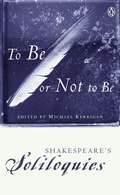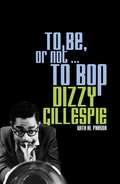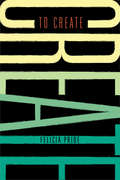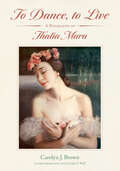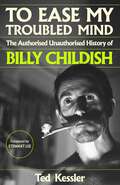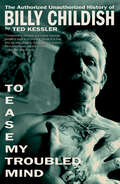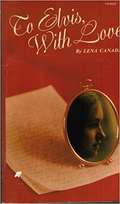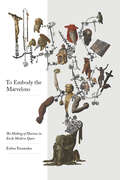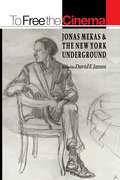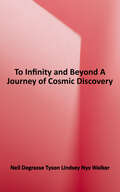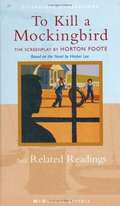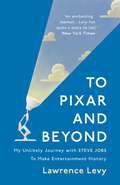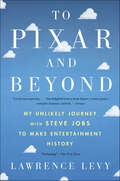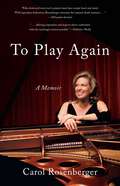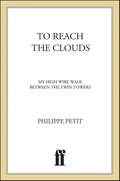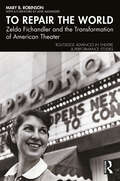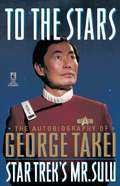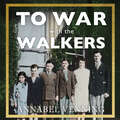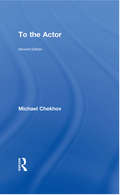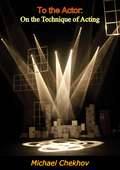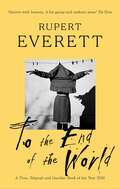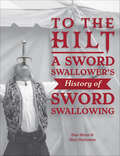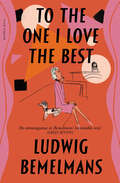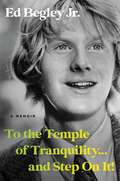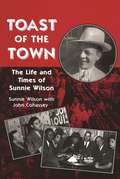- Table View
- List View
To Be or Not to Be: Shakespeare's Soliloquies
by William ShakespeareA unique collection of Shakespeare's soliloquies, each introduced by concise and informative editorial notes. This is an edition to complement the highly successful SHAKESPEARE'S SONNETS and is published in commemoration of Shakespeare's birthday. Aperfect book for Shakespeare lovers and enthusiasts.
To Be, or Not… to Bop
by Dizzy Gillespie Al FraserThis book is a complete, authentic, and authoritative autobiography of Dizzy Gillespie (1917-1993), a jazz musician, ever published.
To Create
by Felicia PrideTo Create is a collection of illuminating interviews with an eclectic set of black artists-including Harry Belafonte, Method Man, Nikki Giovanni, Edwidge Danticat, Edward P. Jones, Booker T. Mattison, and more-as conducted by the writer, entrepreneur, educator, and consultant Felicia Pride. This is an honest, inspiring series of conversations in which Pride and her fellow artists talk openly about the challenges and rewards of working creatively across a multitude of platforms.Over the course of dozens of frank discussions with writers, activists, and media creators, Pride elicits sincere firsthand perspectives on the struggle to find-or to create, if it's not there-a niche for one's voice in the media landscape. The personable and fluid interview style allows the artists to follow their threads of dialogue to unique, intimate revelations.The interviews transition smoothly between similar themes, touching on the do-it-yourself mentality of creating; practical musings on media careers; as well as theoretical discussions on art, legacy, and community. Additionally, many of the artists, musicians, and authors discuss finding career longevity through a multi-platform approach, the connection between the personal and political in art, and the ongoing conflict between art and commerce. This is one of the most candid and diversified interview collections within the African-American community, but it is also a stirring look into what it means to be a creator.
To Dance, to Live: A Biography of Thalia Mara (Willie Morris Books in Memoir and Biography)
by Carolyn J. BrownThalia Mara’s story spans the history of dance in the twentieth century and the rise of the arts in her adopted city of Jackson, Mississippi. As an adolescent Mara (1911–2003) studied with renowned Russian teacher Adolph Bolm, who recommended she go at age sixteen to Paris for further study. During a tour in Europe and South America, she met her partner in dance and life, Arthur Mahoney, and they dazzled the world with their breathtaking performances during the 1930s and '40s. The two were named codirectors of Jacob’s Pillow in 1947, gracing the cover of Life magazine that year. Later they started two schools of dance in New York City, but despite much success, they closed due to lack of funding. That misfortune, however, was Jackson’s boon as it led Mara to the second phase of her career: reviving the Jackson Ballet Company and bringing the USA International Ballet Competition (IBC) to the state.Thalia Mara was recognized at the end of her life not only for the USA IBC’s decision to locate in Jackson, but also for her efforts as a patron of the arts. Her extraordinary fundraising and planning attracted international performers to the city in the 1980s and '90s. To Dance, to Live: A Biography of Thalia Mara gives the first full account of a life devoted to the arts.
To Ease My Troubled Mind: The Authorised Unauthorised History of Billy Childish
by Ted KesslerIn 1977, 17-year-old Steven Hamper was a stonemason in the dockyards of Chatham, Kent. His heart, however, beat in sync with the punk rock tremors of the era, seduced by its celebration of amateurism. So, in a gesture of revolutionary defiance, he took a 3lb club hammer and smashed his hand, vowing to never work again. In doing so, Steven Hamper metamorphosed into Billy Childish, a true renaissance man.Childish has since remained steadfastly true to punk's DIY cred, becoming one of the most recognisable and authentic voices in whichever artistic endeavour he undertakes. He has released over one hundred and fifty albums of raw rock and roll, punk, blues and folk, written many volumes of searing poetry as well as several autobiographical novels. But what he is perhaps best known for in recent years is his painting, for which he is now critically, commercially and internationally feted. He hasn't changed course in any of his disciplines, though. The world just caught up with the sheer volume of his brutally honest work.To Ease My Troubled Mind is a mosaic portrait collated over a year of interviews with Childish, as well as with close family, ex-girlfriends, bandmembers past and present, friends, foes, collaborators, even his therapist. It is an unflinching, yet frequently spiritual and funny portrait of an artist whose obstacle-strewn upbringing formed the backbone of his work: raised in a broken home and abused as a child, Childish was an undiagnosed dyslexic in remedial class at school who is nevertheless now Britain's most prolific and uncompromising creative force.
To Ease My Troubled Mind: The Authorized Unauthorized History of Billy Childish
by Ted KesslerThe story of Billy Childish, the most famous artist you’ve never heard of, by legendary music journalist Ted Kessler In 1977, seventeen-year-old Steven Hamper was a stonemason in the dockyards of Chatham, Kent, in England. His heart, however, beat in sync with the punk rock tremors of the era, seduced by its celebration of amateurism. So, in a gesture of revolutionary defiance, he took a three pound club hammer and smashed his hand, vowing to never work again. In doing so, Steven Hamper metamorphosed into Billy Childish, a true Renaissance man. Childish has since remained steadfastly true to punk’s DIY cred, becoming one of the most recognizable and authentic voices in whichever artistic endeavor he undertakes. He has released over 150 albums of raw rock and roll, punk, blues, and folk; and has written many volumes of searing poetry as well as several autobiographical novels. But what he is perhaps best known for in recent years is his painting, for which he is now critically, commercially, and internationally feted. He hasn’t changed course in any of his disciplines, though. The world just caught up with the sheer volume of his brutally honest work. To Ease My Troubled Mind is a mosaic portrait collated over a year of interviews with Childish, as well as with close family, ex-girlfriends, band members past and present, friends, foes, collaborators, even his therapist. It is an unflinching, yet frequently spiritual and funny portrait of an artist who is now one of the most prolific and uncompromising of his generation. The volume also includes a foreword by British comedian Stewart Lee.
To Elvis with Love
by Lena CanadaLoneliness of a young Swedish nurse's aid trainee named Lena and of an orphan girl named Karen with cerebral palsy is alleviated when they meet and form a close bond. When Karen shares her secret love of Elvis with Lena, they embark on a difficult quest to make contact with him. The story tells of the deep emotional struggles of Lena and Karen--their joys and sorrows, told with sensitivity and compassion.
To Embody the Marvelous: The Making of Illusions in Early Modern Spain
by Esther FernándezIn its exploration of puppetry and animation as the performative media of choice for mastering the art of illusion, To Embody the Marvelous engages with early modern notions of wonder in religious, artistic, and social contexts. From jointed, wood-carved figures of Christ, saintly marionettes that performed hagiographical dramas, experimental puppets and automata in Cervantes' Don Quixote, and the mechanical sets around which playwright Calderón de la Barca devised secular magic shows to deconstruct superstitions, these historical and fictional artifacts reenvisioned religious, artistic, and social notions that led early modern society to critically wrestle with enchantment and disenchantment. The use of animated performance objects in Spanish theatrical contexts during the sixteenth and seventeenth centuries became one of the most effective pedagogical means to engage with civil society. Regardless of social strata, readers and spectators alike were caught up in a paradigm shift wherein belief systems were increasingly governed by reason—even though the discursive primacy of supernatural doxa and Christian wonder remained firmly entrenched. Thanks to their potential for motion, religious and profane puppets, automata, and mechanical stage props deployed a rationalized sense of wonder that illustrates the relationship between faith and reason, reevaluates the boundaries of fiction in art and entertainment cultures, acknowledges the rise of science and technology, and questions normative authority.
To Free the Cinema: Jonas Mekas and the New York Underground
by David E. JamesJonas Mekas, one of the driving forces behind New York's alternative film culture from the 1950s through the 1980s, made for an unlikely counterculture hero: a Lithuanian emigr and fervent nationalist from an agrarian family, he had not grown up with either capitalist commercialism or the postwar rebellion against it. By focusing on his sensitivity to political struggle, however, leading film commentators here offer fascinating insights into Mekas's career as a writer, film distributor, and film-maker, while exploring the history of independent cinema in New York since World War II. <P><P>This collection of essays, interviews, and photographs addresses such topics as Mekas's column in the Village Voice, his foundation and editorship of Film Culture, his role in the establishment of Anthology Film Archives and The Film-Makers Co-op (the major distribution center for independent film), his interaction with other artists, including John Lennon and Yoko Ono, and finally the critical assessment of his own films, from Guns of the Trees and The Brig in the sixties to the diary films that followed Walden. The contributors to this volume are Paul Arthur, Vyt Bakaitis, Stan Brakhage, Robert Breer, Rudy Burckhardt, David Curtis, Richard Foreman, Tom Gunning, Bob Harris, J. Hoberman, David E. James, Marjorie Keller, Peter Kubelka, George Kuchar, Richard Leacock, Barbara Moore, Peter Moore, Scott Nygren, John Pruitt, Lauren Rabinovitz, Michael Renov, Jeffrey K. Ruoff, and Maureen Turim.
To Infinity and Beyond: A Journey of Cosmic Discovery
by Neil DeGrasse Tyson Lindsey Nyx WalkerThis enlightening illustrated narrative by the world's most celebrated astrophysicist explains the universe from the solar system to the farthest reaches of space with authority and humor. No one can make the mysteries of the universe more comprehensible and fun than Neil deGrasse Tyson. Drawing on mythology, history, and literature alongside his trademark wit and charm-Tyson and StarTalk senior producer Lindsey Nyx Walker bring planetary science down to Earth and principles of astrophysics within reach. In this entertaining book, illustrated with vivid photographs and art, readers travel through space and time, starting with the Big Bang and voyaging to the far reaches of the universe and beyond. Along the way, science greets pop culture as Tyson explains the triumphs-and bloopers-in Hollywood's blockbusters- all part of an entertaining ride through the cosmos. The book begins as we leave Earth, encountering new truths about our planet's atmosphere, the nature of sunlight, and the many missions that have demystified our galactic neighbors. But the farther out we travel, the weirder things get. What's a void and what's a vacuum? How can light be a wave and a particle at the same time? When we finally arrive in the blackness of outer space, Tyson takes on the spookiest phenomena of the cosmos- parallel worlds, black holes, time travel, and more. For science junkies and fans of the conundrums that astrophysicists often ponder, To Infinity and Beyond is an enlightening adventure into the farthest reaches of the cosmos.
To Kill A Mockingbird: Screenplay And Related Readings
by Harper Lee Horton Foote McDougal-Littell StaffA small-town Southern lawyer loses friends and social position when he defends a black man unjustly accused of rape, but gains the esteem of his motherless children.
To Pixar and Beyond: My Unlikely Journey with Steve Jobs to Make Entertainment History
by Lawrence LevyA Sunday Times Best Book of the Year 2017 One day in November 1994, Lawrence Levy received a phone call out of the blue from Steve Jobs, whom he&’d never met, offering him a job running Pixar, a little-known company that had already lost Jobs $50 million. With Pixar&’s prospects looking bleak, it was with some trepidation that Levy accepted the position. After a few weeks he discovered that the situation was even worse than he&’d imagined. Pixar&’s advertising division just about broke even, its graphics software had few customers, its short films didn&’t make any money and, on top of all that, Jobs was pushing to take the company public. Everything was riding on the studio&’s first feature film, codenamed Toy Story, and even then it would have to be one of the most successful animated features of all time… Full of wisdom on bringing business and creativity together, and recounting the touching story of Levy&’s enduring friendship with Jobs, To Pixar and Beyond is a fascinating insider&’s account of one of Hollywood&’s greatest success stories.
To Pixar and Beyond: My Unlikely Journey with Steve Jobs to Make Entertainment History
by Lawrence LevyAn insider's never-before-told story about how a struggling computer animation company called Pixar became one of the greatest entertainment organizations of all time. ¶“Part business book and part thriller—a tale that’s every bit as compelling as the ones Pixar tells in its blockbuster movies.”—Dan Lyons, best-selling author of Disrupted¶After he was dismissed from Apple in the early 1990s, Steve Jobs turned his attention to a little-known graphics company he owned called Pixar. One day, out of the blue, Jobs called Lawrence Levy, a Harvard-trained lawyer and executive to whom he had never spoken before. He hoped to persuade Levy to help him pull Pixar back from the brink of failure. This is the extraordinary story of what happened next: how Jobs and Levy concocted and pulled off a highly improbable plan that transformed Pixar into the Hollywood powerhouse it is today. Levy offers a masterful, firsthand account of how Pixar rose from humble beginnings, what it was like to work so closely with Jobs, and how Pixar’s story offers profound lessons that can apply to many aspects of our professional and personal lives. ¶“[A] delightful book about finance, creative genius, workplace harmony, and luck.”—Fortune ¶“Enchanting.”—The New York Times ¶“I love this book! I think it is brilliant.”—Ed Catmull, cofounder and president of Pixar Animation, president of Disney Animation, and coauthor of the bestseller Creativity Inc. ¶“A natural storyteller, Levy offers an inside look at the business and a fresh, sympathetic view of Jobs.”—Success Magazine¶An Amazon Best Book of 2016 in Business & Leadership • A top pick on Fortune’s Favorite Books of 2016 • A 2017 Axiom Business Book Award winner in Memoir/Biography ¶
To Play Again: A Memoir of Musical Survival
by Carol RosenbergerAt age twenty-one, while she was working with the legendary Nadia Boulanger in France, concert pianist Carol Rosenberger was stricken with paralytic polio—a condition that knocked out the very muscles she needed in order to play. But Rosenberger refused to give up. Over the next ten years, against all medical advice, she struggled to rebuild her technique and regain her life as a musician—and went on to not only play again, but to receive critical acclaim for her performances and recordings. Beautifully written and deeply inspiring, To Play Again is Rosenberger&’s chronicle of making possible the seemingly impossible: overcoming career-ending hardships to perform again.
To Reach the Clouds: My High Wire Walk Between the Twin Towers
by Philippe PetitAn artist of the air re-creates his six-year plot to pull off an act of incomparable beauty and imaginationOne late-summer day, a feat of unimaginable audacity was perpetrated on the twin towers of the World Trade Center. The year was 1974. A hundred thousand people gathered on the ground to watch in awe as twenty-four-year-old high wire artist Philippe Petit made eight crossings between the all-but-completed towers, a quarter mile above the earth, over the course of nearly an hour.Petit's achievement made headlines around the world. Yet few who saw or heard about it realized that it was the fulfillment of a dream he had nurtured for six years, rekindling it each time it was in danger of expiring. His accomplices were a motley crew of foreigners and Americans, who under Petit's direction had conpired, connived, labored, argued, rehearsed, and improvised to make possible an act of unsurpassed aerial artistry.In this visually and verbally stunning book, Petit tells for the first time the dramatic story of this history-making walk, from conception and clandestine planning to the performance and its aftermath. The account draws on Petit's journals, which capture everything from his budgets to his strategies for rigging a high wire in the dead of night between two of the most secure towers in the world. It is animated by photographs taken by two of Petit's collaborators, and by his own wonderfully evocative sketches and unquenchable humor.
To Repair the World: Zelda Fichandler and the Transformation of American Theater (ISSN)
by Mary B. RobinsonThis book is a biography in the form of an oral history about a woman whose founding of Arena Stage in Washington, DC in 1950 shifted live professional theater away from Broadway and inspired the creation of non-profit theaters around the country. Dianne Wiest, James Earl Jones, Stacy Keach, and Jane Alexander, among many others, share their memories of this intrepid pioneering woman during Arena Stage’s early years.As Head of New York University’s Graduate Acting Program for 25 years, Zelda Fichandler also trained a younger generation of gifted actors. Marcia Gay Harden, Rainn Wilson, Mahershala Ali, and other developing actors who became “artist-citizens” under her guidance, talk about the ways in which she transformed their lives.Theater practitioners who have lived during Zelda Fichandler’s time will find this book a fascinating and entertaining read––as will all theater lovers, especially those in Washington, DC. And through this vivid and compelling oral history, students and aspiring artists will come to grasp how the theatrical past can shed essential light on the theater of today and tomorrow.
To The Stars: The Autobiography of George Takei (Star Trek)
by George TakeiBest known as Mr. Sulu, helmsman of the Starship Enterprise™ and captain of the Starship Excelsior, George Takei is beloved by millions as part of the command team that has taken audiences to new vistas of adventure in Star Trek®—the unprecedented television and feature film phenomenon.From the program’s birth in the changing world of the 1960s and death at the hands of the network to its rebirth in the hearts and minds of loyal fans, the Star Trek story has blazed its own path into our recent cultural history, leading to a series of blockbuster feature films and three new versions of Star Trek for television. The Star Trek story is one of boundless hope and crushing disappointment, wrenching rivalries and incredible achievements. It is also the story of how, after nearly thirty years, the cast of characters from a unique but poorly rated television show have come to be known to millions of Americans and people around the world as family. For George Takei, the Star Trek adventure is intertwined with his personal odyssey through adversity in which four-year-old George and his family were forced by the United States government into internment camps during World War II. Star Trek means much more to George Takei than an extraordinary career that has spanned thirty years. For an American whose ideals faced such a severe test, Star Trek represents a shining embodiment of the American Dream—the promise of an optimistic future in which people from all over the world contribute to a common destiny.
To War With the Walkers: One Family's Extraordinary Story of the Second World War
by Annabel Venning'A sensationally good book . . . I see reflections of my own family, and beyond them, like those mirrors tilted slightly into infinity, I can see literally miles of others lined up, inexorably linked forever by a shared experience . . . this is an exceptional book and should be required reading in modern history classes' JOANNA LUMLEY 'An extraordinary, compelling picture of a family entwined in the Second World War . . . at turns funny, sad, redemptive and tragic. Fabulous' JAMES HOLLAND 'A moving book . . . This account of one family's experience takes us to hidden crannies of the war that more official accounts might not bother with . . . Once read, never forgotten' THE TIMES 'Uplifting and enlightening . . . Venning has a good eye for what makes the Walker story both unique and universal' MAIL ON SUNDAY 'Superb . . . With its sweeping narrative, readable style, sense of humanity and breadth of research, the saga casts a highly personal light on some of the most significant episodes of [the Second World War]' DAILY EXPRESS 'A heart-pounding narrative that feels fresh . . . this marvellous book also depicts a world that was soon to vanish' DAILY MAIL 'A loving tribute . . . Brimming with anecdote and rich in fascinating detail' KEGGIE CAREW ~The miraculous story of the Walkers, six siblings who survived Blitz, battle and internment and whose incredible experiences tell a new social history of WW2, told by historian and Walker descendant Annabel Venning. How would it feel if all your sons and daughters were caught up in war? What would it be like to spend six years fearing what a telegram might bring? That was the heart-wrenching reality faced by so many families throughout the Second World War, including the parents of the Walker children. From the Blitz to the battlefields of Europe and the Far East, this is the remarkable story of four brothers and two sisters who were swept along by the momentous events of the war. Harold was a surgeon in a London hospital alongside his sister Ruth, a nurse, when the bombs began to fall in 1940. Peter was captured in the fall of Singapore. Edward fought the Germans in Italy, and Walter the Japanese in Burma, while in London, glamorous Bee hoped for lasting happiness with an American airman. In To War With the Walkers, Annabel Venning, Walter's granddaughter, tells the enthralling and moving tales of her relatives, six ordinary young men and women, who each faced an extraordinary struggle for survival(P) 2019 Hodder & Stoughton Ltd
To the Actor: On the Technique of Acting
by Michael Chekhov Mala PowersMichael Chekhov's classic work To the Actor has been revised and expanded by Mala Powers to explain, clearly and concisely, the essential techniques for every actor from developing a character to strengthen awareness. Chekhov's simple and practical method – successfully used by professional actors all over the world – trains the actor's imagination and body to fulfill its potential. To the Actor includes a previously unpublished chapter on 'Psychological Gesture', translated into English by the celebrated director Andrei Malaev - Babel; a new biographical overview by Mala Powers; and a foreword by Simon Callow. This book is a vital text for actors and directors including acting and theatre history students.
To the Actor: On the Technique of Acting
by Michael Chekov Yul BrynnerIn To the Actor Michael Chekhov has recorded brilliantly the results of his many years of experimenting, testing and verifying in the professional theater and schools of the theater. He brings to actors far greater insight into themselves and the characters they are to portray, which enables them to approach any role with new ease and skill.“To the Actor is by far the best book that I have read on the subject of acting. Actors, directors, writers and critics will be grateful for it. It should prove enlightening to theatergoers who wish to deepen their appreciation for fine acting and thus help to invigorate the theatrical art.”—Gregory Peck“I think without a doubt every creative person in the theater will want to have it as a constant reference book, outside of its being, in my opinion, absorbing and entertaining reading.”—Yul Brynner (from the Preface)“One of the most remarkable and practical books on the technique of acting I have ever read....Enthusiastically recommended to all theatre collections of whatever size.”—Library Journal
To the End of the World: Travels with Oscar Wilde
by Rupert EverettA Times, Telegraph and Guardian Book of the Year 2020 'Quivers with honesty, A-list gossip and sardonic prose' The Times'Everett is a deliciously gifted writer. Nothing and no one escapes his attention' ObserverIn his highly anticipated third memoir, Rupert Everett tells the story of how he set out to make a film of Oscar Wilde's last days, and how that ten-year quest almost destroyed him. (And everyone else.)Travelling across Europe for the film, he weaves in extraordinary tales from his past, remembering wild times, freak encounters and lost friends. There are celebrities, of course. But we also meet glamorous but doomed Aunt Peta, who introduces Rupert (aged three) to the joys of make-up. In '90s Paris, his great friend Lychee burns bright, and is gone. While in '70s London, a 'weirdly tall, beyond size zero' teenage Rupert is expelled from the Central School of Speech and Drama. Unflinchingly honest and hugely entertaining, To the End of the World offers a unique insight into the 'snakes and ladders' of filmmaking. It is also a soulful and thought-provoking autobiography from one of our best-loved and most talented actors and writers.
To the Hilt: A Sword Swallower's History of Sword Swallowing
by Marc Hartzman Dan MeyerTo the Hilt is a riveting exploration into the mysterious and dangerous world of sword swallowing, charting its history from ancient rituals to modern-day performances. Cowritten by world-renowned sword swallower Dan Meyer and celebrated sideshow historian Marc Hartzman, this volume delves into the lives of over 100 sword swallowers. Meyer, with his numerous world records and vast experience, provides an insider&’s perspective that is unmatched, while Hartzman adds depth with his historical knowledge and engaging writing style. Key Features:Definitive compendium of historical biographies: Highlights the captivating lives of historical sword swallowers from the 1700s to the present, many of whom have never been profiled in other books.Behind the scenes with modern performers: Provides an inside look at the wild stories and experiences of modern sword swallowers, who account for one out of every 300 million people alive today.Expert perspectives: Readers will learn from Dan Meyer, the world&’s leading expert on sword swallowing and viral TEDx presenter, as he shares his unique life experiences and relatable life lessons in his introductory essay.Rare imagery: Contains a treasure trove of rare photographs and ephemera that bring the history of sword swallowing to life.Medical insights: Outlines the medical risks and implications of sword swallowing through a doctor&’s essay included in the book, which serves both as a warning and an elucidation of the phenomenon.To the Hilt is a journey into a world where danger and artistry intersect. Perfect for sideshow enthusiasts, history buffs, or those interested in pushing human capability to its limits in any domain, this book will leave readers both enlightened and amazed.
To the One I Love the Best
by Ludwig BemelmansA witty and charming account of the wildly entertaining Elsie de Wolfe in 1950s Hollywood, recounted by her dear friend, the beloved creator of MadelineLudwig Bemelmans&’ charming intergenerational friendship with the late-in-life &“First Lady of Interior Decoration&” provides an enormously enjoyable nostalgia trip to the sun-soaked glamour of Los Angeles, where de Wolfe surrounded herself with classic movie stars and a luminous parade of life's oddities. With hilarity and mischief that de Wolfe would no doubt approve, To the One I Love the Best lifts the curtain on 1950s Hollywood--a bygone world of extravagance and eccentricity, where the parties are held in circus tents and populated by ravishing movie stars. Bemelmans, who was working at MGM, had originally come to the California home of de Wolfe just for cocktails but by the end of the night, he was firmly established as a member of the family: given a bedroom in their sumptuous house, invitations to the most outrageous parties in Hollywood, and the friendship of the larger-than-life woman known to her closest friends simply as 'Mother'. To the One I Love the Best (which refers to de Wolfe&’s dog) is a touching tribute to a fabulously funny woman and an American icon. Be pretty if you can, be witty if you must, but be gracious if it kills you. - Elsie de Wolfe
To the Temple of Tranquility...And Step On It!: A Memoir
by Ed Begley Jr.Beloved actor and environmental activist Ed Begley Jr. shares hilarious and poignant stories of his improbable life, focusing on his relationship with his legendary father, adventures with Hollywood icons, the origins of his environmental activism, addiction and recovery, and his lifelong search for wisdom and common ground. Ed Begley Jr. is truly one of a kind, a performer who is known equally for his prolific film and television career and his environmental activism. From an appearance on My Three Sons to a notable role in Mary Hartman, Mary Hartman to starring in St. Elsewhere—as well as films with Jack Nicholson, Meryl Streep, and mockumentarian Christopher Guest—Begley has worked with just about everyone in Hollywood. His "green" bona fides date back to 1970, and have been the topic of two books, a reality show, countless media appearances, and even repeated spoofs on The Simpsons (in one episode, Begley's solar‑powered car stalls out on train tracks, but is saved when the train is revealed to be an "Ed Begley Solar‑Powered Train&”). In To the Temple of Tranquility...And Step On It!, Begley shares a fountain of hilarious and poignant stories throughout his life. The memoir is candid and endearing; in one chapter, he is summoned to Marlon Brando's house to discuss the practical uses of electric eels. In another, he tells the story of taking Annette Bening to the Oscars in &“an oddball kit-car that had gull wing doors, and was nearly impossible to get in or out of, unless you were a yoga master, which fortunately she was.&” Not to mention insightful and surprising tales about The Beatles, Monty Python, Richard Pryor, Cesar Chavez, Jeff Goldblum, Tom Waits, Arnold Schwarzenegger, Carrie Fisher, and so many more luminaries. Begley&’s unmistakable voice is honest and revealing in a way that only a comic of his caliber can accomplish. Behind all the stories, Begley has wisdom to impart. This is a book about family, friends, addiction, failure, and redemption.
